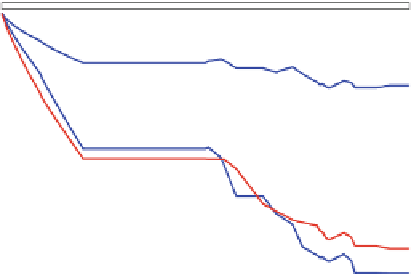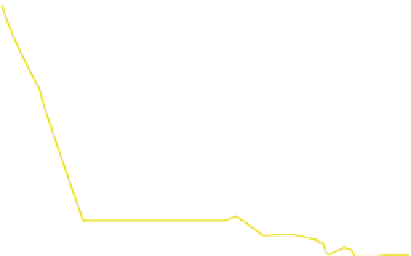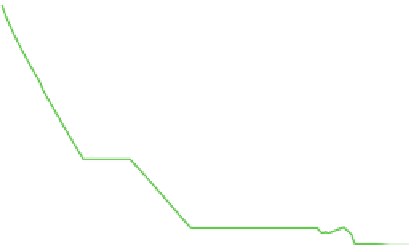Geology Reference
In-Depth Information
variation of sea level
ʔ
SL
above the present day value
(Steckler and Watts
1978
) is given by:
(~20-40 Myr) of uplift and subsidence periods (Figs.
12.4
and
12.5
). The main difference between this study and
previous studies is related to the interpretation of the
“
Red-
S
ρ
m
ρ
s
ρ
m
ρ
m
ρ
w
”
Y
¼
ρ
m
ρ
w
þ
W
d
ʔ
SL
ð
12
1
Þ
beds
sequence. This sequence is attributed to the Karoo
Supergroup in this new study, and to the Neo-Proterozoic
(Cahen et al.
1959
,
1960
) or the Early Paleozoic (Daly et al.
1992
; Kadima Kabongo et al.
2011b
) in the previous works.
This debate is probably not finalised, because of the absence
of the typical characteristics of the Gondwana series
(diamictites and varves of the Gondwana glaciation and
fossils like Gangamopteris and Glosseopteris) in the
:
where
ρ
w
are the mantle, the sediment and the water
(air) densities respectively.
The determination of the
ρ
m
,
ρ
s
,
requires
the knowledge of the sediment thickness, the
paleobathymetry and the eustatic level at each step back in
time. Therefore, the stratigraphic and sedimentologic
constraints are the most critical information. The ideas
about the formation and evolution of the CB have changed
since the time the seismic lines were acquired and the deep
boreholes were drilled in the seventies, but recently several
studies attempted to relate the formation of the CB to a large
gravity low superposed to the basin (Downey and Gurnis
2009
; Crosby et al.
2010
; Kadima Kabongo et al.
2011b
;
Buiter et al.
2012
).
The origin of the CB was initially related to the deposi-
tion of a Paleozoic to Neogene
“
tectonic subsidence
”
“
Red
beds
sequences, but it is beyond the scope of this chapter
(see discussion in other chapters of this topic, e.g. Linol et al.
2013a
,
b
). The important aspect is that the subsidence of the
Congo basin starts within the upper Neo-Proterozoic
(Cryogenian), i.e. prior the
”
deposition.
The long term accumulation of sediments in the CB has
been related to the formation of a Neo-Proterozoic rift (Daly
et al.
1992
; Crosby et al.
2010
; Kadima Kabongo et al.
2011b
), but several authors (Heine et al.
2008
; Downey
and Gurnis
2009
; Moucha and Forte
2011
) related it to
dynamic subsidence. However, dynamic subsidence cannot
be the primary cause of basin formation and evolution over
several hundred million years. Subsidence related to mantle
flow is likely an additional effect superposed on the long-
term evolution. The alternation of periods of subsidence and
“
Red beds
”
sequence
overlying a Precambrian basement including the Neo-
Proterozoic sediments (Cahen
1954
; Lepersonne
1977
;
Cahen and Lepersonne
1978
). More recently, Lawrence
and Makazu (
1988
), Daly et al. (
1992
) and Kadima Kabongo
et al. (
2011a
) used the seismic reflection lines correlated
with four deep wells and outcrop data to subdivide the
sedimentary succession into three main seismo-stratigraphic
units (A, B, C) separated by two regional unconformities
(U2 and U3). The basal Unit A corresponds to the
“
platform
”
0
500
1000
1500
2000
2500
3000
3500
4000
4500
5000
5500
6000
6500
Tectonic Subsidence
300
“
Schisto-
250
200
Calcaire
bandaka and Gilson
wells (Esso Za
¨
re
1981a
,
b
), and correlated to the outcrop-
ping
”
sequence defined in the M
'
groups that belong to the
Cryogenian/Ediacaran Lindi Supergroup (700-630 Myr).
The top of Unit A is limited by a Pan-African unconformity
(U2). The middle Unit B corresponds to discontinuous
Paleozoic deposits including the
“
Ituri
”
and
“
Lokoma
”
MBD1
GLS1
SMB1
Burial
DKS1
sequence
observed at the bottom of Dekese and Samba wells (Cahen
et al.
1959
,
1960
) and the Lukuga Formations. The
“
Red beds
”
“
Red
700
650
600
550
500
450
400
350
300
250
200
150
100
50
0
Time (Ma)
beds
”
sequence is overlain in turn by the
“
Lukuga
”
Forma-
tion in the Dekese, Gilson and M
bandaka wells or is directly
capped by the Upper-Jurassic/lower-Cretaceous unconfor-
mity as in the Samba well (Cahen et al.
1959
). The upper
Unit C corresponds to the Mesozoic (
'
Fig. 12.4
Tectonic Subsidence and burial of the basement for the four
deep wells drilled in the Intracratonic Congo Basin. The
curves
have
been constructed with the recent stratigraphy of Linol et al. (
2013c
,
d
)
for the upper part and the stratigraphic interpretation of Kadima
Kabongo et al. (
2011a
) for the lower part (before PanAFrican
Uncomformity). The tectonic subsidence is calculated with a method
similar to that proposed by Sclater and Christie (
1980
) including the
effects of sediment compaction, paleobathymetry or paleoelevation
taken from the study of Linol et al. (
2013c
,
d
) and the first-order
variations of the sea-level. We show also three tectonic subsidence
curves calculated with a numerical 1D model (Lucazeau and Le
Douaran
1985
) including a finite duration rifting and the blanketting
effect of sediments, for three different lithosphere thickness (200, 250
and 350 km)
“
Haute Lueki
”
,
“
”
“
”
“
”
“
”
Stanleyville
,
Loia
,
Bokungu
and
Kwango
) and
Cenozoic (
) deposits.
Recently, this stratigraphy was revised (Linol
2013
, unpub-
lished; Linol et al.
2013c
,
d
) using modern sequence stratig-
raphy analysis and new biostratigraphy and chronology of
detrital zircons from the Dekese and Samba wells. This
study focuses mainly on the upper Paleozoic and Mesozoic
deposits, and shows that
“
Gr`s Polymorphes
”
and
“
Sables
”
there are successive episodes



































































































































Search WWH ::

Custom Search